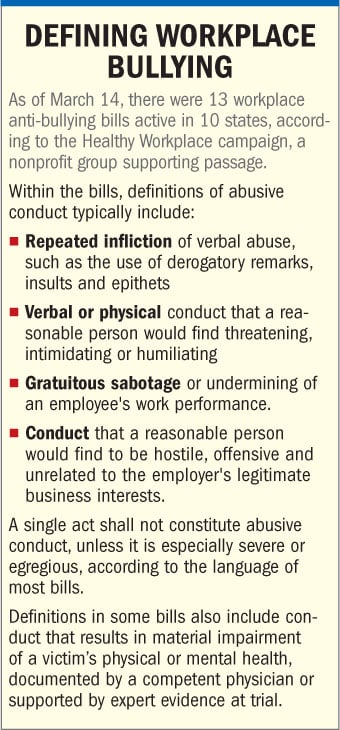"Status-blind harassment"—more commonly known as workplace bullying—is a growing concern to employers and their employment practices liability insurers. But while the costs of having bullies in the workplace are clear, appropriate steps to recognize and rein in the problem aren't always obvious.
Experts use the term "status-blind" or "equal-opportunity harassment" to distinguish workplace bullying from harassment targeted at classes of workers protected under federal and state statutes, such as Title VII, which prohibits discrimination based on race, religion, sex or national origin.
 "It's the boss who abuses his or her power not because someone is a woman over the age of 40 or Hispanic, but rather because the boss wants to bully and is a bully—and anyone who gets in the way is going to be a victim of that bullying, says Gerald Maatman Jr., a partner of Seyfarth Shaw in Chicago.
"It's the boss who abuses his or her power not because someone is a woman over the age of 40 or Hispanic, but rather because the boss wants to bully and is a bully—and anyone who gets in the way is going to be a victim of that bullying, says Gerald Maatman Jr., a partner of Seyfarth Shaw in Chicago.
Recommended For You
Want to continue reading?
Become a Free PropertyCasualty360 Digital Reader
Your access to unlimited PropertyCasualty360 content isn’t changing.
Once you are an ALM digital member, you’ll receive:
- Breaking insurance news and analysis, on-site and via our newsletters and custom alerts
- Weekly Insurance Speak podcast featuring exclusive interviews with industry leaders
- Educational webcasts, white papers, and ebooks from industry thought leaders
- Critical converage of the employee benefits and financial advisory markets on our other ALM sites, BenefitsPRO and ThinkAdvisor
Already have an account? Sign In Now
© Touchpoint Markets, All Rights Reserved. Request academic re-use from www.copyright.com. All other uses, submit a request to [email protected]. For more inforrmation visit Asset & Logo Licensing.







